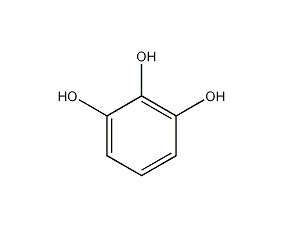Pyrogallol


Structural formula
| Business number | 01YC |
|---|---|
| Molecular formula | C6H6O3 |
| Molecular weight | 126.11 |
| label |
Pyrogallic acid, pyrogenol, pyrogallic acid, pyrogallol, 1,2,3-Trihydroxybenzene, 1,2,3-Ploroglucinol, 1,2,3-Trihydroxybenzene, 1,2,3-Benzenetriol, Polymerization inhibitor, developer, oxygen absorber, hair conditioner |
Numbering system
CAS number:87-66-1
MDL number:MFCD00002192
EINECS number:201-762-9
RTECS number:UX2800000
BRN number:907431
PubChem number:24898098
Physical property data
1. Properties: White odorless crystals. Has a bitter taste. Turns gray when exposed to air and light. Slowly heat and begin to sublimate. When exposed to air, the aqueous solution darkens in color, while its caustic solution changes color quickly and is low in toxicity.
2. Density (g/mL, 20/4℃): 1.45
3. Relative density (20℃, 4℃): 1.4534
4. Melting point (ºC): 131~133
5. Boiling point (ºC, normal pressure): 309℃ (1.01kpa)
6. Normal temperature Refractive index (n25): 1.561134
7. Refractive index (n134D): 1.561
8. Flash point (ºC): Undetermined
9. Specific rotation (º): Undetermined
10. Autoignition point or ignition temperature (ºC): Undetermined
11. Vapor pressure (kPa, 25ºC): Undetermined
12. Saturated vapor pressure ( kPa, 60ºC): Undetermined
13. Heat of combustion (KJ/mol): Undetermined
14. Critical temperature (ºC): Undetermined
15. Critical pressure (KPa): Undetermined
16. Log value of oil-water (octanol/water) distribution coefficient: Undetermined
17. Explosion upper limit (%, V/ V): Undetermined
18. Lower explosion limit (%, V/V): Undetermined
19. Solubility: Soluble in water, ethanol, ether, slightly soluble in benzene , chloroform, carbon disulfide.
Toxicological data
It is highly irritating to skin and mucous membranes, direct contact with skin should be avoided. When this product is swallowed, it can cause severe damage to the digestive organs, liver, and kidneys, leading to hemolysis, lethargy, collapse, and even death. The oral lethal dose for dogs is 23mg/kg.
Ecological data
None yetPolymerizing agents, pharmaceutical and dye intermediates, and analytical reagents, etc. Pyrogallic acid is used as an oxygen absorber in gas analysis, and in cosmetics, it is used in face powder, hair conditioners, hair dyes, etc. Used as polymerization inhibitor for styrene and polystyrene. It is also used to prepare metal colloidal solutions, film developers, infrared photography thermosensitizers, medicines and dyes, etc. It is used as an oxygen absorber in gas analysis and used in cosmetics such as face powder, hair conditioner, hair dye, etc. 2.Used as a reducing agent for the determination of gold by gravimetric method, an absorbent for oxygen in the determination of gases by absorption volume method, and a photometric method for the determination of NbO3– TaO3– chromogen. Also used for qualitative testing, Bi3+, La3+, Co2+, Ce4+, etc. . 3.Used as polymerization inhibitor for styrene, polystyrene and some polymer base materials. It is also used to prepare metal colloidal solutions, film developers, infrared photography thermosensitizers, medicines and dyes, etc. It is used as an oxygen absorber in gas analysis; in cosmetics, it is used in face powder, hair conditioner, hair dye, etc. 4.Widely used in pharmaceutical, dye, chemical and food industries. In the cosmetics industry, it can be used as an oxidative colorant for hair dyeing. It is a toxic substance that is easily effective and mutagenic. Its maximum allowable content is 5%, but it cannot dye eyelashes and eyebrows. Rinse immediately after contact with eyes. It can also be used in face powders and hair conditioners. 5. Used in the manufacture of azo dyes, anthraquinone dyes, etc.